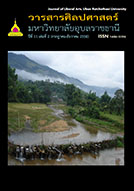ยุทธศาสตร์การดำรงชีพของผู้หญิงไทดำ กลุ่มหัตถกรรมต่ำผ้าไหมเมือง คำ แขวงเชียงขวาง สาธารณรัฐประชาธิปไตยประชาชนลาว
Main Article Content
บทคัดย่อ
ผลการศึกษาพบว่า ผู้หญิงไทดำในหมู่บ้านดังกล่าวมีบทบาทที่สัมพันธ์กับความเป็นเพศคือ เป็นทั้งแม่และภรรยาในครัวเรือนซึ่งเป็นบทบาทดั้งเดิม และปัจจุบันมีบทบาทเพิ่มขึ้นในฐานะผู้หาเลี้ยงครอบครัว จากเดิมจะเป็นหน้าที่ของผู้ชายเท่านั้น ทั้งนี้สามารถมองบทบาทของผู้หญิงไทดำผ่านการทอผ้าออกเป็น 2 ด้าน ได้แก่ หนึ่ง บทบาทด้านเศรษฐกิจ ผู้หญิงกลายเป็นผู้ที่หาเลี้ยงครอบครัว ด้วยการทอผ้าเพื่อขายเป็นสินค้า จากเดิมที่ทอผ้าเพื่อใช้นุ่งห่มและในพิธีกรรมทางวัฒนธรรมต่างๆ เท่านั้น และสอง บทบาทด้านสังคมและวัฒนธรรม ได้แก่ บทบาทการดูแลสมาชิกในครอบครัว ซึ่งเกี่ยวข้องกับการดูแล การเลี้ยงดูครอบครัว และการทำกิจกรรมต่างๆ ในชีวิตประจำวัน ซึ่งยังคงบทบาทเดิมจากอดีต และบทบาทเพื่อชุมชน ได้แก่บทบาทในการอนุรักษ์ศิลปวัฒนธรรมการทอผ้าจากเดิมเป็นกิจกรรมเฉพาะในครอบครัวได้กลายเป็นกิจกรรมทางสังคมที่เปิดโอกาสให้ผู้หญิงได้แสดงบทบาท ความสามารถ และเข้าไปมีส่วนร่วมในการอนุรักษ์วัฒนธรรมของชุมชนด้วย
ผู้หญิงไทดำใช้การทอผ้าเป็นยุทธศาสตร์หนึ่งในการดำรงชีพ โดยได้พัฒนากลวิธีต่างๆ เพื่อรับมือกับสถานการณ์ที่เปลี่ยนแปลงตลอดเวลา โดยปรับใช้ทุนที่สำคัญห้าด้านในการดำรงชีวิต กล่าวคือ หนึ่ง ทุนทางด้านทรัพยากรมนุษย์ ได้แก่ คนที่มีความรู้และความสามารถในการทอผ้า ทักษะ ประสบการณ์ที่สะสมไว้ หรือสืบทอดมาจากบรรพบุรุษ รวมทั้งความรู้ที่อยู่ในตัวบุคคล สอง ทุนทางด้านกายภาพ ได้แก่ โครงสร้างพื้นฐานและสิ่งที่จำเป็นต่อการดำรงชีพประกอบไปด้วยเส้นทางเข้าหมู่บ้านเชียงเกี่ยวที่สะดวกสบายที่สามารถส่งออกสินค้าได้ สาม ทุนทางการเงิน ได้แก่ ฐานะทางการเงิน การออม และการเข้าถึงแหล่งเงินทุน โดยมีกองทุนสนับสนุนของหมู่บ้านเป็นแหล่งเงินทุนหมุนเวียนสำหรับการลงทุนเพื่อพัฒนาอาชีพ สี่ ทุนทางด้านทรัพยากรธรรมชาติ โดยใช้ไม้เป็นส่วนประกอบในการสร้างอุปกรณ์การทอผ้าและใช้กาบไม้มาย้อมผ้า และห้าทุนทางสังคม ได้แก่การเข้ารวมกลุ่มหัตถกรรมต่ำผ้าไหมเมืองคำ ซึ่งมีความสำคัญอย่างมากต่อการผลิต ส่งออกสินค้า และการพัฒนาฝีมือและผลิตภัณฑ์
This qualitative research aims to explore the changing roles and survival strategies of Tai Dam women as seen through their fabric weaving practice. It focuses on a silk hand-weaving group in Xieng Khiaw Village, Kham District, Xieng Khouang Province in the Lao People’s Democratic Republic. Its data collection methods include documentary research, interviews, and focus groups. The data were descriptive analyzed through the conceptual frameworks of women’s gender roles and survival strategies.
The research findings show that the gender roles of Tai Dam women in Xieng Khiaw Village were those of mother and wife within the household. However, these women had increasingly become the family breadwinner, which was the traditional role of men. The women played a prominent role in many areas. Economically, they played the role of family earner by weaving fabrics for sales when fabrics were traditionally woven for cloths and ritual use. In terms of their social and cultural role, the women were caregivers: they provided care to and raised their family members and performed traditional duties on a daily basis. In addition, the women in Xieng Khiaw Village served their community by preserving local arts and culture. Traditionally, weaving was considered as an exclusive family activity. However, it had increasingly become a social activity which allowed women to showcase their roles and abilities and partake in the preservation of community culture.
The Tai Dam women in Xieng Khiaw Village employed fabric weaving practice as one of their survival strategies and developed many different methods of coping with ever changing situations. They adapted and relied on 5 types of capital – human, physical, financial, natural, and social – to make a living. Human capital refers to people with weaving knowledge and skill, a stock of experience accumulated by living people or passed on from ancestors, and knowledge one possesses in one’s self. Physical capital includes infrastructures and basic needs. For the women in Xieng Khiaw Village, it narrowly meant the road going into their village, which facilitated the transport of their products. Financial capital refers to financial status, saving, and access to resources of capital. Village fund was established to provide capital for the villagers to use in their investment and career development. Natural capital involves equipment for handloom making and tree barks for fabric dyeing. Social capital includes being part of the weaver group in Kham District. Being a member of this group is important not only for the women to develop their weaving skill but also for the production, distribution, and development of their product as a whole.

